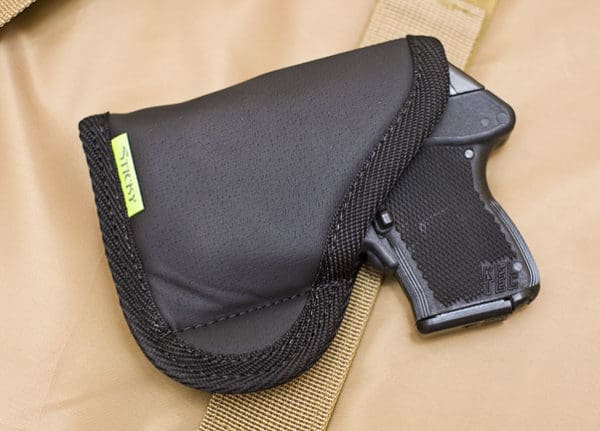Pocket carry is hardly new. People have been stuffing derringers in to their vests and Colt 1903’s in their jackets for well over a century. But the method seems to have grown in popularity with the liberalization of carry laws and expanded interest in concealed carry. During our Concealed Carry Tactics class at The Range at Austin we demonstrate various backup guns along with their their pro’s and con’s. Stuffing one in a pocket seems to be the favored method for toting a backup gat for most students.
Necessity is the mother of invention
My first experiment with pocket carry arose out of necessity when it took longer than expected to get an ankle holster I’d ordered for my J-frame revolver. The delay forced me to find a backup carry method for my backup gun, and that was a good thing.
I’d played on and off again with various forms of pocket carry over the years, but until my new rig arrived, I was determined to do a proper evaluation. To see just hat works, what doesn’t and why. My six-month test lead me to a conclusion . . .
One size definitely does not fit all
Those who pocket carry come in all different shapes and sizes as do the firearms they select. My gun of choice for this little exercise was a Smith & Wesson M&P Bodyguard 380. I started off with the most common pocket carry position — front pocket, strong side.
But I discovered a major problem right off the bat. Access can be questionable under certain circumstances. Since I commute to work, sit at a desk a lot while working and during meals (most of the time), easy access in those situations was severely hampered.
I don’t care what type of clothing you wear, it’s almost impossible to retrieve items quickly from a front pocket while seated. Try pulling out some loose change next time you’re sitting. Notice how you end up arching your back and doing a hip bridge just to get all the way down there.
To add to the problem, the girth of your hand increases when it’s wrapped around your gun in you pocket. Depending on the fit of your breeches, that makes a smooth, quick draw even more challenging. Add to that various sizes, depths and access angles of front pockets and at the very least, you’re going to severely degrade your drawstroke.
Wrapping your mitt around a pistol in a snug front pocket can be like the old Indian monkey trap. When the critter grabs a fistful of delicious rice, he becomes ensnared. His closed fist is too large to fit back out through the hole. Similar result with front pocket carry. I resolved not to be that monkey.
So with all the variables of pocket size, depth and angle of access, I switched to a rear pocket instead.
Most back pockets are of a patch design and even if they’re not, they’re all pretty similar in size. The only hitch: back pockets are usually fairly shallow and pistol the size of my snubby can sometimes poke out the top. That’s usually easily addressed with a proper cover garment, but when sitting in public while back-pocket carrying, I have to be more mindful.
The big benefit, though, is that access can be a lot quicker from a back pocket. When I preformed side-by-side baseline tests of front and back pocket draw strokes, the back pocket was more consistent and, in my experience, more reliable.
Those tests, however, were done while on my feet. When seated, it wasn’t even a contest. A slight shift of my butt cheek while reaching back coupled with a clean clearance of the cover garment netted me a consistently smoother draw stroke from the rear.
The takeaway: I’ve grown fond of carrying two guns lately. And ease and speed of access I get with back pocket carry offers me what many of the other backup gun carry methods failed to do; it keeps things simple.
Jeff Gonzales is a former US. Navy SEAL and preeminent weapons and tactics instructor. He brings his Naval Special Warfare mindset, operational success and lessons learned unapologetically to the world at large. Currently he is the Director of Training at The Range at Austin. Learn more about his passion and what he does at therangeuastin.com.
